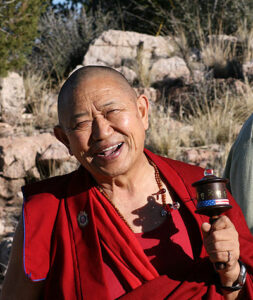Explaining the Refuge Card
People have asked many questions regarding the meaning of refuge, and for that reason I have created this new refuge card. The Drikung Kagyü owes its name to Lord Jigten Sumgön, who possesses many unique qualities of enlightened body, speech, and mind. I will share something about these qualities from my own personal understanding.
To represent the qualities of the enlightened body, there is an image of Jigten Sumgön on the refuge card. This is not just any picture. This picture is of a statue called “The Tooth-Printed One,” and it is one of the most important holy objects at Gar Monastery, where it is kept because it contains many blessings.
In the past, Gardampa Chödingpa traveled to Nepal, where he made many statues of Jigten Sumgön. He made the statues in two sizes: larger ones about a half-foot in length, and others that were very small. When Gar Chödingpa offered these statues for consecration, he asked Jigten Sumgön, “Do you think it looks like you?”
Jigten Sumgön picked up one of the large statues and looked at it. “It does look like me,” he said, and bit the head of the statue, leaving a tooth imprint on its head. Ever since then, a tooth imprint naturally appeared on the heads of all the larger Jigten Sumgön statues. The larger statues are therefore called “The Tooth-Printed One.”
Jigten Sumgön then picked up one of the small statues and placed it into his mouth. He handed the statue back to Gar Chödingpa and said, “Now it is consecrated.” Thus, the small statues are called “The Mouth-Placed One.”
All of these statues are extremely precious. I myself have seen about thirty or forty of the larger statues, and they all had the tooth imprint. These are very old statues, and people like to collect them: many great lamas from all the different lineages throughout Tibet possess these statues of Jigten Sumgön. In order to introduce everyone to this story, I have added a picture of the larger statue to the refuge card.
As for the quality of enlightened speech, the refuge card says: I take refuge in wisdom, the heart essence of the Buddha. In the Single Intent of the Holy Dharma (Gongchig) by Jigten Sumgön, it says: “Whatever is done in the field of knowable things is done by buddhas.”
Everyone possesses buddha-nature; there is not a single being who does not possess this quality of wisdom within their mind. It is due to this wisdom that they can experience temporary happiness, and can ultimately attain enlightenment. The state of buddhahood is said to be the perfection of wisdom. In brief, what is wisdom? As long as one has not realized the nature of mind, one is ignorant, and in that context, the mind is referred to as dualistic consciousness. But when the nature of mind is realized, it is realized to be self-knowing wisdom. This is why the refuge card says that wisdom is the heart essence of the Buddha.
Next the refuge card says: I take refuge in love and compassion, the heart essence of the Dharma. It is said, “The eighty-four thousand heaps of Dharma are subsumed within bodhicitta.” The buddhas of the three times have all taught the supreme path of bodhicitta. There are two kinds of bodhicitta: relative and ultimate. In order to realize ultimate bodhicitta, one has to realize that there is no self. And in order to realize selflessness, one must give rise to an altruistic mind.
Then the refuge card says: I take refuge in virtuous friends, the heart essence of companions. In the context of the refuge vows, the companion is the spiritual friend or spiritual master. Actually, if you consider any teacher of a worldly or spiritual system to be your virtuous friend, you can achieve happiness within that system. I believe it is important to show faith and respect to all teachers. Thus, the essence of companions is the virtuous friend. The intent of their enlightened speech is all the same.
Regarding the quality of the enlightened mind, Lord Jigten Sumgön said in the Gongchig: “The very heart of the three vows is one within the conduct.” Ultimately, the three levels of vows— Individual Liberation, Bodhisattva, and Vajrayāna—are one. “One” because when immeasurable love arises and one realizes the view of Mahāmudrā, one will naturally abandon harming others, and in this way one naturally accomplishes the benefit of others. Therefore, the card says: When harm to others and its cause are abandoned, the vows of Individual Liberation are complete. When help to others and its cause are accomplished, the vows of Bodhisattvas are complete. When one is skilled in a pure perception of the universe and all beings, the vows of Secret Mantra are complete.
For example, if the altruistic mind of bodhicitta arises within one’s mind, then, as Milarepa said: “The ten virtues will become the natural expression of conduct.” In this way, harming others will naturally cease. When one gives up harming others, helping others and its causes are accomplished. When one keeps the bodhisattva vows, the benefit of others will naturally be accomplished. The essence of the bodhisattva vows is the six paramitās.
When one is skilled in the pure perception of the universe and all beings, the vows of Secret Mantra are complete. Drikung Dharmaraja said: “The universe of appearances and existence should be understood to be the form of the deity. This is the perfection of the Secret Mantra’s generation stage.”
When the momentary obscurations of sentient beings are dispelled, there are no real sentient beings to be found. The universe and all beings are pure on their basis; they are only obscured by temporary stains. What is meant by “pure?” Dualistic perceptions, such as the created labels of “saṃsāra and nirvāṇa” and so on, all arise due to ignorance, and are thus “impure.” One develops a pure view of the universe and all beings when all such dualistic grasping is purified.
Consciousness perceives everything in a dualistic way, and as long as there is dualistic grasping, there is saṃsāra. When one sees the nature of consciousness, one becomes free of dualistic grasping, and when dualistic grasping is purified, everything will appear naturally pure. A field of infinite purity opens up when one sees the universe and all beings as pure. The Heart Sutra speaks about “looking right at the experience of the profound perfection of wisdom.” Pure view arises from such a recognition of the true nature of one’s own consciousness. So while deluded consciousness perceives a duality, when there is no more dualistic perception, it is called primordial wisdom. Marpa Lotsawa said: “When you realize it, it is self-knowing awareness.”
Next the refuge card says: Do not commit any wrong. Perfectly practice virtue. Completely tame your own mind. This is the Buddha’s teaching. When precious bodhicitta arises in your mind, the ten non-virtues will become naturally purified, and you will naturally practice the ten virtues. What does “taming one’s mind” mean? What we have to tame is self-grasping. When there is no more self-grasping, self and others become inseparable. For example, the only difference between you and others is like the difference between ice and water. The nature of ice is water; it is only temporarily in a frozen state, which is like the temporary stain of believing in the existence of a self. So taming one’s mind means to tame self-grasping. The eighty-four thousand heaps of Dharma are all taught as methods of purifying self-grasping.
There is also an image of the Buddha Śhākyamuni in the refuge card. It is an image of the main Buddha statue in Bodhgaya, the place where the Buddha reached enlightenment. This statue sits on the very spot where the Buddha reached enlightenment, and it is believed to be his exact likeness. Because it is so precious to glimpse the form of the Buddha in this infinite universe, I added this image to the refuge card.
Also on the refuge card is an image of Tara, who is the Great Mother, the Perfection of Wisdom. Thus, the Three Jewels are all represented in the refuge card. The Buddha is represented by the image of Buddha Śhākyamuni, the Dharma by an image of the Great Dharmakāya Mother Tara, and since I am the one giving you the refuge vows, there is also an image of me to represent the Sangha. The enlightened body, speech, and mind of all the buddhas of the three times are complete within the spiritual master.
Translated by Ina Bieler and edited by Dan Clarke in 2019.



